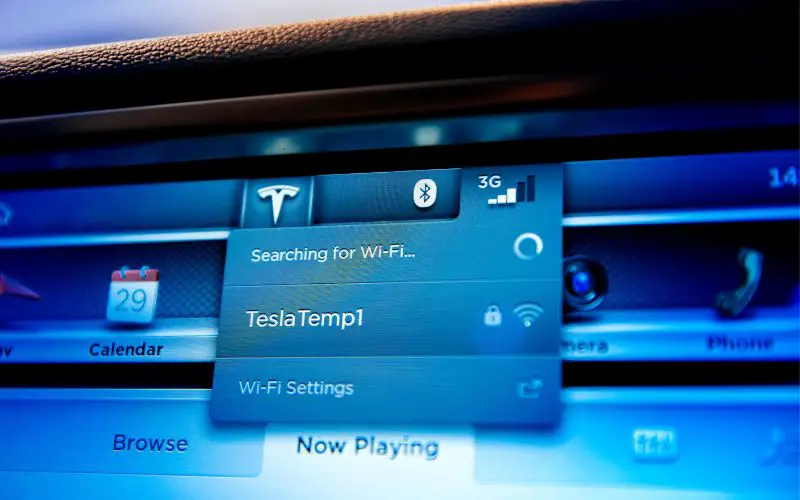4 Possible Reasons Your Tesla Won’t Connect To Wi-Fi!
Everyone wants to once in a while go out in their Tesla while connected to a Wi-fi network where they can easily access their music files or use virtual assistant apps like Alexa efficiently.
Therefore, having your Tesla refuse to connect to your internet would be frustrating, especially if it has always been an easy and almost automated function.
But how can you know the solution to this issue if you do not know the reasons that have caused it?
Your Tesla will not connect to Wi-fi due to antenna issues or a weak access range. It could also result from using the wrong wireless bandwidth, SIM system issues, and outdated software. To fix these issues, consider running a software update, resetting Wi-fi settings, and using Wi-fi extenders if the issue is due to a weak access range.
In this article, I will tell you the best ways to deal with Wi-fi connection issues on your Tesla and the primary reasons why your Tesla won’t connect to the internet.
Furthermore, I will explain in detail how you can get your Tesla connection working again through simple DIY steps.
Why Is My Tesla Not Connecting To Wi-Fi?

Having your Wi-fi trip without prior issues can frustrate Tesla owners, especially if you can’t listen to music, use your GPS, or give virtual commands.
The reasons why your Tesla’s Wi-fi is not connecting can be as basic as poor access range or more complex like wrong wireless bandwidth issues.
Without wasting so much time, let’s quickly run through the reasons your Tesla’s Wi-fi won’t connect.
#1. SIM System Issue
When your Tesla has a SIM system issue, you may see an error message on the screen that reads, ‘Wi-fi is turned off.’
However, this error message disappears when you restart or drive your Tesla.
#2. System Update Issue
Usually, before a system app gets outdated, it will display essential updates on the screen so that you can run them almost immediately.
Unfortunately, as with so many people, Tesla owners ignore updates such as the FSD Beta 10.69.2.2, which can result in network connection issues.
#3. Poor Access Range
Like your phones, your Tesla can detect and connect automatically to networks they previously connected to.
Nevertheless, low or poor access ranges can cause the Wi-fi network to remain undetected, no matter how secure or strong the network’s strength is.
For this issue, Wi-fi extenders always come in handy, and I recommend suitable extenders such as the TP-Link AC1900 Wi-fi Extender (RE550)
#4. Antenna Issues
The antennas on your side mirrors can develop issues that will make it impossible for your Tesla to pick up signals connected to any Wi-fi network until they get fixed.
Most times, the fault could be from a single bandwidth shift. Ensure the Wi-fi bandwidth gets set to 2.5 GHz and not more than this.
Below is a table showing the Wi-fi bandwidth for all four models of Tesla cars
| Tesla Model | Wi-fi Bandwidth |
|---|---|
| Model S | 2.5 GHz |
| Model X | 2.5 – 5.0 GHZ |
| Model 3 | 2.5 GHz |
| Model Y | 2.5 GHz, 5.0GHz |
How Do I Get My Tesla’s Wi-fi to Work?
When you encounter some of the issues I have mentioned above, the best thing you can do is run a diagnostic check on your Tesla or troubleshoot.
You can reboot your Tesla by pressing the two steering wheel buttons for 5 to 10 seconds.
Most times, troubleshooting fixes every issue except for some very complicated errors that need detailed attention and repair.
There are other ways to get your Tesla’s Wi-fi up and running smoothly again.
#1. Run A System Reboot
Most Teslas have a bandwidth of 2.5 GHz and use the WPA or WPA2 security encryption for internet access.
Usually, once your router or phone has a secure connection, the bandwidth gets set, and you have a secure connection, you can go ahead to run a system reboot.
Here are the steps you should follow when running a system reboot.
- Put your Tesla in park mode.
- Press and hold down your brake pads.
- Press and hold the two buttons installed on your Tesla’s steering wheels till the screen goes off. This usually takes about 10 to 15 seconds.
- Wait for 15 minutes after the screen goes for the reset process to start.
- After that, you will see a yellow or orange spot to show that your system is ready for an update. Click on the update options and allow the process complete.
- Wait for a list of available Wi-fi to appear on the screen, then choose anyone to connect to it. You should be able to have an easy connection.
Tip:
Do not disconnect, plug or touch anything when you start the system reboot. Only open the car when the process is complete.
#2. Run A Software Update
The Tesla Wi-fi will often not turn on if the system software becomes outdated and needs an update.
However, if you keep pushing away update prompts displayed on your screen, you may soon have more than Wi-fi connection issues to fix.
Here is how to run a software update on your Tesla.
- Switch on your Bluetooth and your Tesla screen.
- Pair your phone via Bluetooth to the Tesla screen.
- You can now operate your Tesla using the Tesla app installed on your phone.
- Once you navigate the Tesla app, you will see an on-screen prompt where the screen will show you the latest version of the system software to download.
- Click on the INSTALL option, and your Tesla will start updating.
- Allow it to finish installing, then turn off the Tesla screen.
- The issue should get fixed when you switch your screen back on.
#3. Poor Access Range
Wi-fi connections work effectively over specific ranges; no matter how this may seem, there is so little you can do about how far a Wi-fi connection can go.
If you are out at a distance far from where your Wi-fi location, you can’t access the network due to low access points.
Here is how to fix this issue
- Navigate to the Wi-fi icon bar.
- Turn on and off the Wi-fi to be sure that you have any connection at the range where you are.
- After confirmation, you can now go ahead to install a Wi-fi extender such as TP-LINK AC1900 (RE550).
- After installing the Wi-fi extender, click on the Wi-fi icon on the Tesla screen and connect to the network.
#4. Antenna Issue
The antenna on your Tesla could either be detachable or not. They can often move out of place since they are located outside the car near the passenger’s side mirror.
Thus, developing Wi-fi network issues. However, fixing a Tesla antenna is one of the most straightforward issues when fixing Wi-fi connection issues.
Here are some DIY steps you should follow to fix antenna issues
- Ensure your bandwidth connection gets set to at least 2.5 GHz.
- Check your antenna to know what type you have, i.e., detachable or non-detachable.
- If you have a detachable antenna, uninstall it and install it securely.
- After that, connect your Tesla to your phone’s Bluetooth and test it.
- Your antenna issues should get fixed after you do this, and your Wi-fi connection should be restored.
How Do I Reset My Tesla Internet?
After carefully going through why your Tesla could develop Wi-fi issues, fixing any of those issues will mean resetting your Tesla screen.
While resetting your Tesla, you can also run a software update to clear any other issues and fix bugs.
Follow the steps below to reset your Tesla internet issues.
- The first thing to do is restart your modem or router.
- Check the setting on your router and reset it appropriately.
- After this, check your router for poor network, signal strength, and connectivity issues.
- The next step is to run troubleshooting on your Tesla screen.
- After doing this, run a software update.
- Wait for a few minutes and test your internet and signal strength.

Hey, I’m Michael Davis, a 35-year-old with a degree and a love for cars and tech. Since I was a kid, cars have been my thing—so much that I even thought they ran on magic beans! Fast forward, and I’ve built Vehicle Army, your one-stop-shop for easy-to-understand car facts.






